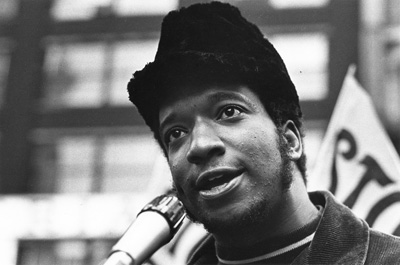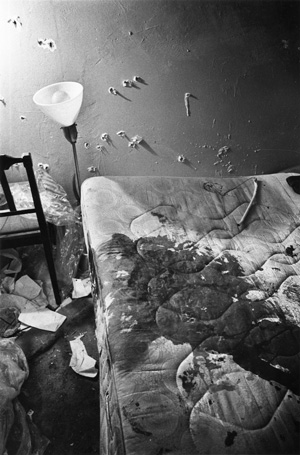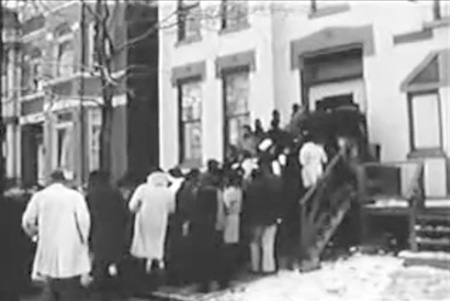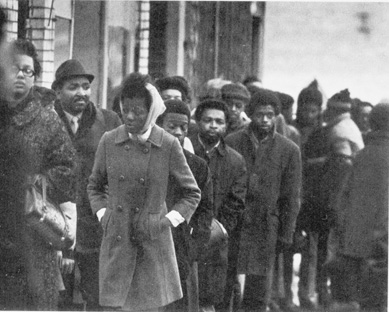Revolution #184, November 29, 2009, updated with editor note December 4, 2015
December 4 marks the 46th anniversary of the assasination of Fred Hampton, orchestrated by the FBI and carried out by the Chicago Police. We are reposting here for our readers an article originally posted in 2009.
December 1969: The FBI Assassination of Fred Hampton
"I AM... A REVOLUTIONARY!"
 |
| Photo: Paul Sequeira |
December 4, 1969—40 years ago this week: Chicago police led by Cook County prosecutor Edward Hanrahan as part of an FBI Counter Intelligence Program (COINTELPRO) operation stormed into Illinois Black Panther Party Chairman Fred Hampton's apartment. Armed with shotguns, handguns, and a .45 caliber machine gun, and guided by a floor plan of the apartment provided by an informant, the police killed Mark Clark and critically injured four other Panthers. They gunned their way through the apartment into Fred Hampton's bedroom. There he lay sleeping, having been drugged earlier by an FBI informant. As he lay there, the cops stood over him and put two bullets in his brain, at close range. Following this murderous attack—where the police fired nearly 100 rounds in the house and were completely uninjured themselves—Hanrahan brazenly lied that the police were under heavy fire from the Panthers.
 |
| The cops stood over Fred Hampton as he lay sleeping and put two
bullets in his brain at close range. Above, Fred Hampton’s bed after his
murder. Photo: Paul Sequeira |
Among all the many thousands and thousands of actions that show why the Black Panther Party correctly dubbed the police "pigs," few compare to the viciousness and lies surrounding the assassination of Fred Hampton.
The media took up and spread these lies from the authorities as if they were the whole truth and nothing but the truth. But the Panthers in Chicago—still shocked and grieving from the terrible loss of their key leader, and with many of their core members now in jail—refused to give up. Instead, they turned to the people and mounted a defiant political counter-offensive. The Panthers organized "people's tours" of the apartment. Thousands came, first from the ghettos and then more broadly. Film crews and reporters were brought in. People saw with their own eyes. And the evidence was clear: All the bullet holes were coming in. The famous picture supplied by the authorities and run in the Chicago Tribune at the time, of a door supposedly riddled with bullets coming from the Panthers, was shown to be a door with nail holes.
Even mainstream commentators felt compelled to speak out. Hanrahan had claimed that it was only through the "grace of God" that his men escaped with scratches. Mike Royko, then a columnist at the Chicago Daily News—and no Panther supporter—wrote in response, "Indeed it does appear that miracles occurred. The Panthers' bullets must have dissolved into the air before they hit anybody or anything. Either that or the Panthers were shooting in the wrong direction—namely, at themselves." (Cited in The Assassination of Fred Hampton: How the FBI and the Chicago Police Murdered a Black Panther, page 102, by Jeffrey Haas, Lawrence Hill Books)
 |
| The Panthers’ “people’s tours” of Fred Hampton’s apartment. Thousands came from the
ghettos and beyond, film crews and reporters were brought in. |
Fred Hampton was a 21-year-old leader of the Panthers who inspired all kinds of people to take up revolution. As Bob Avakian says in his memoir, "many people throughout the country had been moved by Fred Hampton and had made a leap in their revolutionary commitment because of his influence—the whole way in which, before he was killed, he boldly put forward: ‘You can kill a revolutionary, but you can't kill the revolution.'" (From Ike to Mao… and Beyond: My Journey from Mainstream America to Revolutionary Communist, Insight Press).
In one short year from the founding of the Black Panther Party in Illinois to the time of Fred's murder, there was a transformation in the culture of society in Chicago. Based on the teachings of Mao Testung, the leader of the Chinese revolution, there was a "serve the people" ethos and culture the likes of which Chicago had not seen before. The Panthers set up free clinics in neighborhoods of the oppressed, where before health care had been virtually unavailable. The Black Panther newspaper was sold everywhere. Posters from the paper were used for political education sessions in the communities and on campuses. Former gangbangers and student intellectuals became revolutionaries. The culture was so widespread in Chicago that conductors on the el and subway trains would announce "All power to the people" when calling out the stops where revolutionaries were getting off the train.
Hampton's assassination was part of a broad campaign to smash the Black Panther Party and the burgeoning revolutionary movement that burst onto the scene in the 1960s. In September 1968, notorious FBI Director J. Edgar Hoover called the Panthers "the greatest threat to the internal security of the country," and by 1969 the Panthers were the number one target of the FBI's COINTELPRO operations, which included 233 different documented operations from assassinations like those of Fred Hampton and Mark Clark, to attempts to turn street gangs against the Panthers, efforts to create divisions within the BPP, and setting up Panthers on false criminal charges. Hoover specifically aimed to prevent the rise of what he called "a Black messiah"—that is, he focused on taking out leaders and potential leaders of the masses. Revolutionaries like Malcolm X, George Jackson, Bunchy Carter and John Huggins in LA, and Fred Hampton were either directly murdered by the government, or set up. These were counter-revolutionary criminal acts—not only were innocent people murdered by the U.S. government, but the ability of the masses of people to raise their heads and liberate themselves was grievously set back.
 |
| People lined up for blocks outside funeral home to honor Fred Hampton. Photo: Paul Sequeira |
Fred Hampton drew forward the best from among all these sections of the people, inspiring them with a revolutionary vision and calling on them to rise to being revolutionaries. And many thousands heeded the call. His famous chant "I am…a revolutionary" was transformative, as people would take it up, thinking seriously as they did so about what they were committing their lives to when they said it.
Leadership is critical to making revolution. Although revolutionary leaders like Fred Hampton were taken from the people, and others capitulated to capitalism and gave up on revolution, the spirit of devoting your life to making revolution and doing all you can to hasten the day when revolution can be made still lives—most of all in the leadership being given today by Bob Avakian, Chairman of the RCP, who worked and struggled closely with the Black Panther Party when it was the most advanced revolutionary force in the U.S. The possibility for revolution, right here in the belly of the beast of U.S. imperialism as well as around the world, is greatly heightened because of the leadership of Bob Avakian and the RCP.
Humanity still cries out for the revolution that Fred Hampton devoted his life to. As the Constitution of the RCP says: "The emancipation of all humanity: this, and nothing less than this, is our goal. There is no greater cause, no greater purpose to which to dedicate our lives."
If you like this article, subscribe, donate to and sustain Revolution newspaper.



